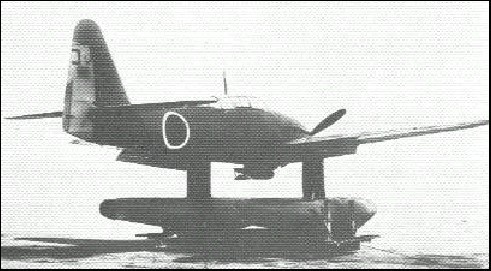Design and development.. Tervezés és fejlesztés:
From the late 1920s, the Imperial Japanese Navy had developed a doctrine of operating floatplanes from submarines to search for targets. [ 2 ] In 1941, however, a scheme was developed to use aircraft launched from large submarines for offensive action, with Admiral Isoroku Yamamoto ordering the construction of eighteen I-400 class submarine aircraft carrier (also designated STo or sen-toku - special submarine). A 1920-as évek végén, a Japán Császári Haditengerészet kifejlesztett egy tan-től működő floatplanes tengeralattjárók keresni célokat. [2] 1941-ben, azonban a kifejlesztett rendszer használata repülőgép indult a nagy tengeralattjárók támadó fellépés, az Admiral Isoroku Yamamoto elrendelő építése tizennyolc I-400 osztályú repülőgép-hordozó tengeralattjáró (STO is kijelölt, vagy sen-toku - speciális tengeralattjáró). It was planned that the submarines would surface to launch their aircraft by catapult , which, if all went well, would ditch besides the submarines after making their attack, with the aircraft not expected to be reusable. [ 3 ] [ 4 ] Úgy tervezték, hogy a tengeralattjárók volna felület indítani, hogy a repülőgép katapult , amely, ha minden jól megy, azt árok mellett a tengeralattjáró, miután a támadást, a légi jármű nem lesz újrafelhasználható. [3] [4]
To equip the submarine aircraft carriers, the Imperial Japanese Navy Air Service requested that Aichi design a folding attack aircraft with a range of 1,500 km (800 nautical miles ) and a speed of 556 km/h (300 knots). Ellátni a repülőgép-hordozó tengeralattjáró, a Japán Császári Haditengerészet Air Service kérte, hogy Aicsi design összecsukható csapásmérő repülőgép egy sor 1500 km (800 tengeri mérföld ) és a sebesség 556 km / h (300 csomó). Aichi's design, designated AM-24 by Aichi and given the military designation M6A1, was a two-seat, low-winged monoplane powered by a 1,400 hp Aichi AE1P Atsuta 30 engine (a licence-built copy of the Daimler-Benz DB 601 liquid-cooled V12 engine ). Aichi design kijelölt AM-24 az Aicsi és mivel a katonai megnevezés M6A1, egy kétüléses, kis szárnyas monoplán hajtott egy 1400 lóerős Aichi AE1P Atsuta 30 motor (engedély épült másolatát a Daimler-Benz DB 601 folyékony léghűtéses V12 motor ). The original specification dispensed with a traditional undercarriage but it was later decided to fit the aircraft with detachable twin floats to increase its versatility. Az eredeti specifikáció nélkülözhető a hagyományos alváz, de később úgy döntött, hogy illeszkedik a repülőgép levehető két úszók, hogy növelje a sokoldalúság. If conditions permitted, these would allow the aircraft to alight next to the submarine, be recovered by crane and then re-used. Ha a körülmények lehetővé, ezek lehetővé tenné, hogy a repülőgép leszálláshoz mellett a tengeralattjáró, vissza kell követelni a daru, majd újra használni. The floats could be jettisoned in flight to increase performance. [ 5 ] Both wings and the aircraft's tail folded to allow storage within the submarine's 3.5 m (11 ft 6 in) diameter cylindrical hangar. Az úszók lehet dobni repülés közben a teljesítmény növelése. [5] mindkét szárnya, és a repülőgép farka hajtva, hogy a tárolási tengeralattjáró 3,5 m (11 láb 6) átmérőjű hengeres hangárba. Armament was a single 850 kg (1,870 lb) torpedo or an equivalent weight in bombs. Fegyverzet volt, egy 850 kg (£ 1870), torpedó, vagy hasonló mennyiségű bomba. One 13 mm Type 2 machine gun was mounted on a flexible mounting for use by the observer.














































